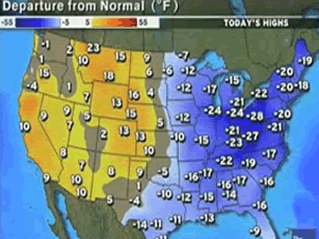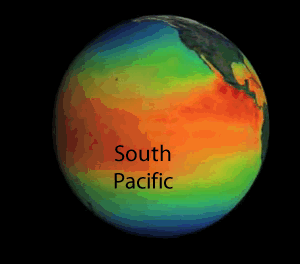Weather is not Climate
"Last year was a bitterly cold winter. What's this thing about climate change?" We often hear people refer to a weather anomaly to prove that climate change is not real.
Many people confuse weather for climate. Weather has a high degree of chaotic variability

The temperature map of the USA for January 16th 2009 is shown on the right. The map shows deviation from normal temperature on this day. The eastern part of the USA was blinded by a cold snap with average temperatures 10 degrees Fahrenheit below normal. However on the other side average temperatures were 10 degrees above normal.
Now the land mass involved represents 1.6% of the total surface of the earth. What can you say about these temperature differences and global warming? Nothing! This is weather not long term climate change.

So what causes such chaotic variability year to year?
Ocean surface temperature has a powerful effect on global temperature. The heat held in ocean waters is far greater than that held in the atmosphere. The largest reservoir of ocean heat is probably in the southwestern Pacific where small changes in surface temperature spews out an enormous amount of heat into the atmosphere.
This heat reservoir in the southwestern Pacific moves about in a 5 year cycle, on average. When it does move, it travels across the eastern Pacific and piles up on the coast of South America. This is known as an El Nino. When this phenomenon happened in 2007 cherry blossoms bloomed in Washington DC in January.
As the warm surface waters of the eastern Pacific dissipate they are replaced with cold water that sucks an enormous amount of energy out of the air. This has a tremendous influence on surface temperature and rainfall and is called La Nina.

The graph on the right shows the trend in global temperature .
Click to see the impact of El Nino (peaks) and La Nina (trough). Although the graph shows a trend upwards, year to year fluctuations occur. It is clear that the El Nino-La Nina cycle has a major impact on global temperature.
The period 1991-1992, shown with red circle, reveals a period of cool temperatures even though there is a moderate El Nino effect. The reason for this is a major volcanic eruption in 1991 of Mount Pinatubo which blasted reflective particles into the atmosphere and lowered the average global temperature for up to a year, after which the normal patterns were reasserted.

1) What is the difference between weather and climate?
2) What is the El Nino effect and describe how it comes about?
3) What is the La Nina effect and describe how it comes about?
4) What is the effect of volcanic eruptions on global temperatures? Explain
5) What is the specific heat capacity of water?
6) If the specific heat capacity of dry air is 1.0 j/g/C, that is, it takes 1 joule of energy to raise the temperature of 1 gram of dry air by 1 degree Celsius, the amount of heat energy released when 3.00 gram of dry air at 23 oC falls to 20 oC?